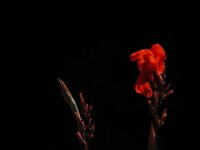Can't say "why" it happened but it does seems almost as though a spot metering exposure setting was taken from the highlights on the flowers. Either that or perhaps there was an accidental and substantial negative exposure compensation (sorry, not being a digiscoper or having a Coolpix myself I don't know what Andy's recommended settings are). Essentially, if you take a spot metering reading from something, this something will come out with the brightness of "mid-grey/gray" in your final picture. For your picture, you'd normally want the mid-lit parts of the petals to come out mid-grey brightness and the other parts coming out with a tonal range from quite dark to almost white. As regards the background, if that in real life was much darker than the darkest parts of the flower, for the one shot, you'd just have to sacrifice it and accept that it will come out black. It's possible if you'd given a bit more exposure, you might have revealed a bit of detail in the background. But, as Ian says, much more and you'll find substantial parts of the flower will become white.
With extremely high contrast situations like this, it might be worth considering doing exposure bracketing (or Best Shot mode on the Coolpix??). Then, as you have your camera on a tripod and your subject hasn't been moving much, you would have a sequence of pictures identical except in that they each would have the separate components of the picture nicely exposed. Using Photoshop layers, you might then be able to create a composite which has satisfactory detail for you in both the foreground and background.
If you didn't use spot metering and you didn't have exposure compensation on then I would suggest you've found a situation that has fooled the camera's metering system. I can't see anything in your picture, as posted, that would qualify, in exposure terms, as a "highlight" or virtually white.
It's an interesting one.





